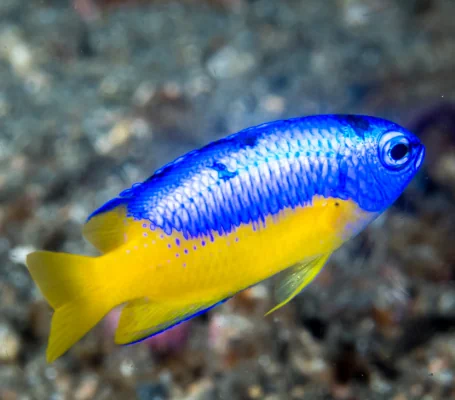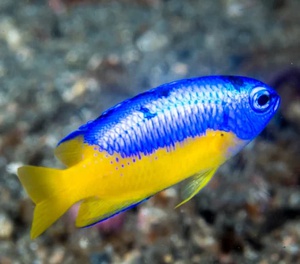Three blue damsels from the Pomacentrus genus are very common in the aquarium trade and all have very similar common names that may even be interchanged in some references, including "Electric Blue Damsel" or "Neon Blue Damsel". These three damsels are the Allen's Damsel (P. alleni), the Yellow Belly Damsel (P. auriventris) and the Neon Damsel (P. coelestis). A few other less common damsels also resemble these three.
The Yellow Belly Damsel (P. auriventris) is metallic blue and may sometimes be iridescent as well. The bottom half of the fish and the tail is bright yellow or gold, usually forming a sharp L-shaped color change towards the rear of the fish.
Damsels and chromis both come from the Pomacentridae family, which they share with Clownfish, a close relative and another very popular group of aquarium fish. Their temperament can range from very peaceful to quite aggressive and territorial. Chromis (fish from the genus Chromis) tend to be more peaceful than the rest but can also be more delicate. Other common genuses of damsels include Amblyglyphidodon, Chrysiptera, Dascyllus, Neoglyphidodon, Pomacentrus, Stegastes and others.
These fish are generally not picky eaters. In the aquarium, they will usually feed on flakes and pellets but should also be given fresh or frozen algae and meaty foods like brine shrimp, mysis shrimp, planktons, krill, shrimp, scallop and similar items.
Damsels can become very territorial as they become established in the aquarium. Some species will defend their territory especially aggressively; use caution when stocking the aquarium since their small sizes can be deceiving; mature or established damsels may pick on smaller or weaker fish or on new arrivals. Some damsels retain the same appearance throughout their entire lives while others undergo a radical color change as they mature from juveniles to adults. A few may get more colorful as adults but most change from very colorful juveniles to bland, more subdued adults.


